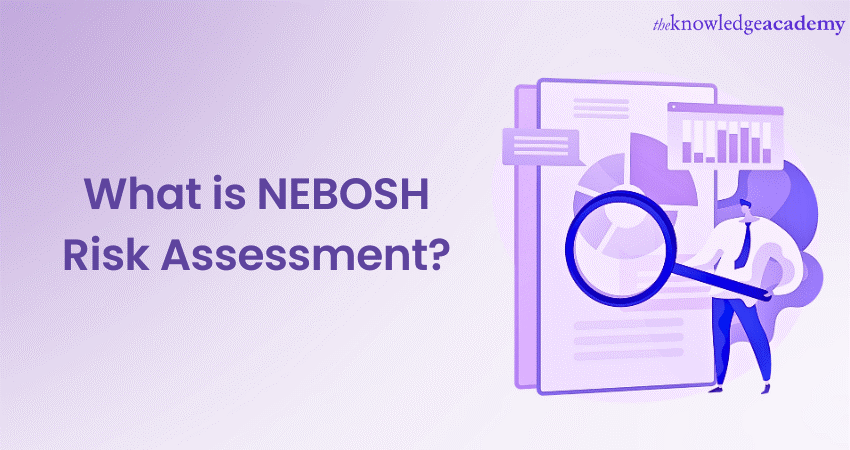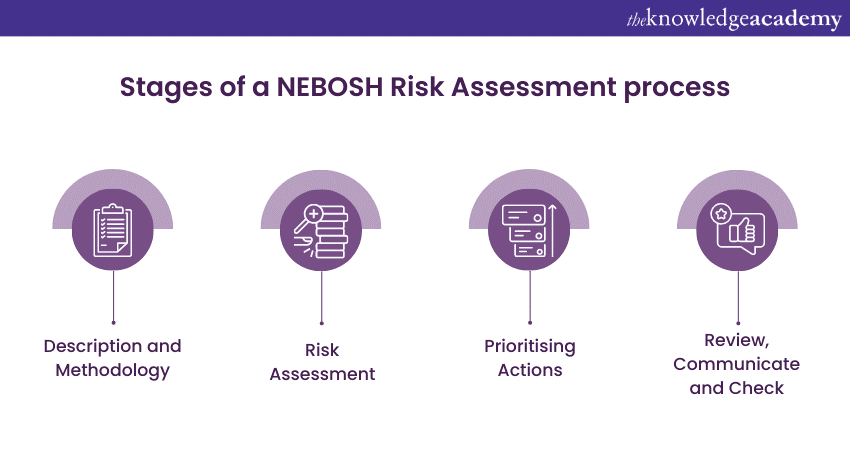We may not have the course you’re looking for. If you enquire or give us a call on 01344203999 and speak to our training experts, we may still be able to help with your training requirements.
Training Outcomes Within Your Budget!
We ensure quality, budget-alignment, and timely delivery by our expert instructors.

Meeting health and safety requirements is an essential element of any modern-day organisation. An organisation should always aim to ensure the good health and adequate safety of its employees in the workplace. To ensure this, it should be updated with the latest globally recognised standards for health and safety. The National Examination Board in Occupational Safety and Health (NEBOSH) offers qualifications covering health and safety management. Among them, the General Certificate requires you to do a NEBOSH Risk Assessment.
According to PayScale.com, the average salary for a health and safety manager is £35,704, but it could go up to £51,000 depending on one’s experience, location in the UK, sector, and job demands. To earn a similar package, a General Certificate comes in handy, but one must go through the final phase of the exam. The Risk Assessment is the final phase of your NEBOSH exam and requires you to conduct a detailed audit of an organisation to secure your qualification. You will learn all about NEBOSH Risk Assessment in this blog. From stages to passing tips, it covers everything you need to know to build your skills.
Table of Contents
1) What does Risk Assessment mean?
2) How do I fill out a NEBOSH Risk Assessment form?
3) Stages of a NEBOSH Risk Assessment process
a) Description and methodology
b) Risk Assessment
c) Prioritising Actions
d) Review, Communicate and Check
4) How do you know you have passed the NEBOSH Risk Assessment?
5) Conclusion
What does Risk Assessment mean?
A risk assessment requires conducting a detailed assessment of health and safety risks in an organisation. This involves an overall risk assessment of the workplace, prioritising tasks, recognising common hazards, assessing risks, and recommending control policies and actions. If you're studying for a NEBOSH certificate-level qualification, you must complete a practical risk assessment of your workplace. This assesses your practical ability to apply your learning to a real-life scenario.
It's important to note that there is no written face-to-face exam for risk assessmen; instead, it’s only evaluated through practical evaluation. The practical evaluation involves performing a Risk Assessment in an actual workplace and writing a detailed Risk Management Report on a pre-established NEBOSH template. The Risk Assessment includes basic information about the workplace and methods used, an evaluation of at least 10 hazards selected from several subject areas covered in Unit IG2. The evaluation also includes an action plan to address the identified problems, as well as a list of the top three priority actions with a detailed explanation and rationale.
Join our NEBOSH National General Certificate in Occupational Health And Safety course to effectively manage health and safety standards at your workplace.
How do I fill out a NEBOSH Risk Assessment form?
To complete a NEBOSH Risk Assessment form, you must conduct a risk evaluation of a workplace that identifies a variety of hazards applicable to every department in the organisation. The evaluation should communicate the actions for improvements to the relevant people.
Although you can complete the risk assessment on your own time, it should take an estimated three hours to complete, and it's vital to use the time wisely. Completing the evaluation well ahead of schedule may result in inadequate detail. The assessment process has four stages, each with a separate marking criterion that needs to be passed. Though there are word counts for each stage, some flexibility is permitted.
The risk assessment doesn't have any numerical mark or rating, only a pass or failure. However, there is a qualifying criterion for each of the four stages in the risk assessment process. You must pass each of the four stages to pass the overall evaluation.
Join our NEBOSH HSE Certificate in Process Safety Management Course and gain complete knowledge of risk management techniques most used in industries.
Stages of a NEBOSH Risk Assessment
As mentioned above, there are four stages in a NEBOSH Risk Assessment process – all of which we will discuss in detail as follows:

Description and methodology
The first stage of the NEBOSH Risk Assessment process requires candidates to gather background information about the organisation being evaluated. This includes the organisation's name, site location, the number of workers, and a general description. Additionally, candidates must describe the area being evaluated and provide other relevant information regarding health and safety in the organisation.
After providing this information, candidates must describe the methodology they used to carry out the assessment. This step allows the NEBOSH examiner to verify the assessment's reliability and validity. In the methodology section, candidates should include the sources of information they consulted, individuals with whom they communicated, how they identified hazards and controls, and any necessary corrective actions. The methodology should be approximately 200 words and is a critical section that may determine success in passing the assessment.
Risk Assessment
The next step in the Risk Assessment process is to identify different hazards from various categories. You must record at least 10 different hazards from seven different categories, using the tables in Part 2 of the assessment package to list them. The seven categories you can choose from are:
1) Physical and psychological hazards
2) Musculoskeletal health
3) Chemical and biological agents
4) General workplace issues
5) Work equipment
6) Fire
7) Electricity
It's important to include the 10 hazards from the seven different categories; failing to meet this requirement may result in failure. You must provide the following details for each hazard to meet the flagging criteria:
1) Hazard and respective category (Column 1)
2) Who might be harmed by the hazard and how (Column 2)
3) What you are already doing (Column 3)
4) What further controls/actions are required (Column 4)
5) The time scale for further actions to be completed (Column 5)
6) The job role of the responsible person (Column 6)
As you work on your assessment, you will notice that Column 3 (what you are doing) and Column 4 (further controls required) will work together. If you are already doing enough to control the risk, you may not need any additional controls. On the other hand, if there are few existing controls, Column 3 will have much more content than Column 4. Both scenarios are acceptable as they are realistic.

Prioritising Actions
The next step in the process requires you to use the table in Part 3 of the evaluation package to prioritise your actions and justify your choices. Once you have identified all the potential risks or dangers to the organisation, you need to choose the three that require the most urgent attention. Be careful to pick three priority actions as choosing only two will result in failure. Your priority actions may be associated with the same or different hazard categories.
Keep in mind that the prescribed actions must be the top priority actions in the organisation. This step should also be accompanied by reasoning or justification as to why these actions need to be performed as a priority. The justification must include moral, legal, and financial arguments, and should be limited to a word limit between 350 and 400 words.
You also need to make a case for why the prescribed actions need to be addressed. These justifications should be mentioned with reference to general legislation, such as the Occupational Health and Safety Act, as well as the legal consequences for the organisation. Any financial impacts, such as sick pay, damaged equipment, and prosecution fees, should also be mentioned. Moral arguments should also be a part of this stage, as protecting employees should be a priority for any organisation.
Review, Communicate and Check
The last step of the evaluation will require you to specify a review date for the risk assessment. One must mention the company policy duration of review of risk assessment. Additionally, a fixed review date should be established from the date the risk profiling is submitted to the organisation, with this period ranging from six months to a year. This period can range from six months to a year. One should also communicate the findings from the assessment to people within the organisation through meetings, e-mail and Tool Box Talks (TBT).
Learn the fundamentals of workplace health and safety by signing up for our NEBOSH Award in Health and Safety At Work course!
How do you know you have passed the NEBOSH Risk Assessment?
As mentioned above, there are no grades for the risk assessment. This means you will either receive a “pass” or a “refer”. While a “pass” would mean that your assessment has been validated, a “refer” would require you to resubmit it. In case you do receive a “refer” for your assessment, ensure that you have included the following key points:
1) The methodology used in the first stage of the risk assessment.
2) The 10 hazards identified from at least seven categories in the second stage.
3) Adequate detail of the hazards and the parties who could be potentially harmed, in the second stage as well.
4) Three prioritized actions in the third stage, with justifications for why these actions need to be performed as a priority. The justifications should include moral, legal, and financial arguments.
5) Specification of how the risk assessment will be communicated and to whom, along with a review date for the assessment.
Conclusion
All in all, you can pass the NEBOSH Risk Assessment with a holistic understanding of what will be required of you in the examination. You will need to demonstrate a solid understanding of how to assess risks in the workplace, suggest prioritised corrective actions, and provide a thorough justification for your choices. By following the steps outlined above, you can achieve a passing grade on the assessment and improve your prospects in the health and safety field.
Boost your chances in the health and safety domain by signing up for our NEBOSH Courses!
Frequently Asked Questions
Upcoming Health & Safety Resources Batches & Dates
Date
 NEBOSH National General Certificate in Occupational Health and Safety
NEBOSH National General Certificate in Occupational Health and Safety







 Top Rated Course
Top Rated Course


 If you wish to make any changes to your course, please
If you wish to make any changes to your course, please


